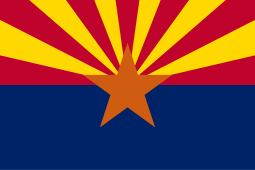Arizona State Route 77
| |||||||
|---|---|---|---|---|---|---|---|
|
SR 77 highlighted in red | |||||||
| Route information | |||||||
| Maintained by ADOT | |||||||
| Length | 253.93 mi[1] (408.66 km) | ||||||
| Existed | 1927 – present | ||||||
| Tourist routes |
| ||||||
| Major junctions | |||||||
| South end |
| ||||||
|
| |||||||
| North end | BIA Route 6 at Navajo Nation boundary | ||||||
| Highway system | |||||||
| |||||||
State Route 77 (or SR 77) is a state highway in Arizona that traverses much of the state's length, stretching from its northern terminus at the boundary of the Navajo Nation north of Holbrook to its junction with I-10 in Tucson.
Route description
At its southern terminus, north of Tucson, the road is known as Oracle Road[3] until the final mile and a half when the road turns westward directly toward Interstate 10 and is called Miracle Mile Road,[3] named such in 1962.[4]

| Wikimedia Commons has media related to Arizona State Route 77. |
Past the Navajo Nation boundary, SR 77 becomes BIA Route 6 northbound towards Keams Canyon. Between Show Low and Globe, this highway is concurrent with U.S. Route 60. Its southernmost reaches were formerly part of U.S. Route 80 and U.S. Route 89, except for its terminal segment, the Miracle Mile segment of old Business 10 and State Route 84A.
Origin of the name of Tucson's Miracle Mile
Although it was thought for several years that Tucson's Miracle Mile derived its name from a June 1937 Arizona Highways magazine, historian David Leighton challenged this theory, in a February 23, 2015, article in the Arizona Daily Star newspaper. He explained that in 1936, real estate developer Stanley Williamson conceived the idea of creating a commercial center outside of the over-congested downtown retail district, in Tucson. His model for this business center was the Miracle Mile in Los Angeles, Calif. The one in L.A., was the idea of real estate agent A.W. Ross, who saw that the retail district in that city was overcrowded and, also saw that cars were becoming more common. He came up with the idea of buying farming land, along Wilshire Blvd., several miles out from downtown, with the belief that as more people bought automobiles they would be willing to drive farther, in order to avoid the lack of parking and congestion in the downtown area. While initially no one thought his idea would work, in time store after store came to his business center. The Miracle Mile eventually became one of Los Angeles' premier shopping districts. Ross originally called his business area, the Wilshire Boulevard Center, it was changed to the Miracle Mile in 1928.
History
SR 77 was designated in 1931 from McNary to Holbrook. In 1938, it was extended to Oracle Junction, and the old route to McNary was cancelled. In 1992, it extended south to its current terminus, replacing a portion of US 89, which was removed from southern Arizona. The section was part of US 80 until 1989.
Junction list
| County | Location | mi[1] | km | Exit | Destinations[5][2][6] | Notes |
|---|---|---|---|---|---|---|
| Pima | Tucson | 0.00 | 0.00 | Exit 255 on I-10 | ||
| 1.49 | 2.40 | Oracle Road | Former US 80 / US 89 / SR 84 east / SR 93 south / SR 789 | |||
| Oro Valley | SR 989 unsigned; serves Oro Valley Hospital | |||||
| Pinal | Oracle Junction | 22.91 | 36.87 | South end of SR 79; former US 80 west / US 89 / SR 789 north | ||
| | Interchange; serves San Manuel Airport | |||||
| Gila | Winkelman | 65.71 | 105.75 | |||
| Globe | 98.52 | 158.55 | South end of US 70 overlap | |||
| 100.57 | 161.85 | South end of US 60 overlap; north end of US 70 overlap | ||||
| Navajo | | |||||
| Show Low | South end of SR 260 overlap | |||||
| North end of SR 260 overlap | ||||||
| 172.20 | 277.13 | North end of US 60 overlap | ||||
| Snowflake | 191.06 | 307.48 | ||||
| Holbrook | 216.12 | 347.81 | ||||
| 217.74 | 350.42 | South end of US 180 overlap | ||||
| 218.47 | 351.59 | North end of US 180 overlap; south end of I-40 BL/Historic US 66 overlap; former US 66 west | ||||
| North end of I-40 BL/Historic US 66 overlap; south end of I-40 overlap; exit 286 on I-40; former US 66 east | ||||||
| 289 | Exit number follows I-40; former US 66 west | |||||
| | 224.86 | 361.88 | North end of I-40 overlap; exit 292 on I-40 | |||
| | 238.79 | 384.30 | BIA Route 6 north | Continuation beyond northern terminus at Navajo Nation boundary | ||
1.000 mi = 1.609 km; 1.000 km = 0.621 mi
| ||||||
See also


External links
References
Route map:
- 1 2 Arizona Department of Transportation. "2008 ADOT Highway Log" (PDF). Retrieved April 9, 2008.
- 1 2 Arizona Department of Transportation (2014). "Arizona Parkways, Historic and Scenic Roads" (PDF). Phoenix: Arizona Department of Transportation. Retrieved September 11, 2018.
- 1 2 Tucson @ AARoads.com
- ↑ Devine, Dave (October 9–15, 1997). "Motel Memories". Tucson Weekly. Tucson.
- ↑ "Historic Arizona U.S. Route 80 Designation". Webpage. Tucson Historic Preservation Foundation. August 2017. Retrieved 30 September 2018.
- ↑ Shell Oil Company; H.M. Gousha Company (1956). Shell Highway Map of Arizona (Map). 1:1,330,560. Chicago: Shell Oil Company. Retrieved March 31, 2015 – via David Rumsey Map Collection.
